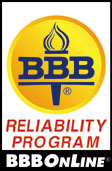Ventless-Gas-Logs.com Knowledgebase
Specializing in Ventless Gas Logs and Ventless Fireplaces
Ventless Gas Appliances - Features that Ensure Safe and Reliable Operation
Oxygen Detection Safety Pilot (ODS) Technology
More than 17 million U.S. households use vent-free gas supplemental heating appliances. Vent-free products are fueled by natural gas or propane and their precision engineered burners provide highly efficient, environmentally clean-burning heat.
Oxygen detection safety pilot (ODS) technology was adopted by all U.S. manufacturers for all vent-free gas products in the early 1980s. ODS technology originated in Europe, and has been used in European gas heating appliances for more than half a century with an outstanding record of safety.
Consumer Product Safety Commission (CPSC) accident/ incident data compiled since 1980 show no documented deaths due to emissions associated with the use of an ODS-equipped vent free gas heating appliance. Industry engineers say the ODS pilot is to gas what a circuit breaker is to electricity.

- Thermocouple: A device consisting of two pieces of dissimilar metals joined together at one end (hot junction). When the hot junction is heated, the thermocouple produces DC voltage to the other end. It powers thermoelectric gas valves and when used is a safety feature on gas hearth products.
- Millivolt (mV): Unit of electromotive force equal to one one-thousandth of a volt.
- Orifice: The opening in a device whereby the flow of gas is controlled and through which the gas is discharged to either a pilot burner or main burner.
- Piezo igniter: A device that delivers an igniting spark by means of pressure on a crystal.
How the ODS (Oxygen Detection Sensor) Works
The ODS system consists of three main components:
- a precisely designed, oxygen sensitive pilot burner that regulates flame characteristics;
- a thermocouple1 positioned in the mantle of the pilot flame; and
- a safety shut-off valve.
The pilot is designed to be stable within a very narrow operating range. The thermocouple responds to changes in the pilot flame characteristics and, when heated, generates a millivoltage2, which keeps the gas supply valve in the open position.
If low levels of oxygen are detected by the ODS system, the flame extinguishes. The loss of flame causes the thermocouple to cool. This cooling reduces the millivoltage, which causes the gas valve to return to its normally closed position, thus turning off the fuel supply to the appliance. The unit will not operate until the living space is properly ventilated and adequate oxygen is introduced, and the appliance is manually restarted.
It's tamper-resistant
Every ODS system contains a precision orifice3. This orifice will disintegrate with any attempt at drilling it out to enlarge the pilot flame. Additionally, it is not interchangeable with a normal standing pilot. Furthermore, propane and natural gas vent-free products cannot be converted from one type of gas to another.
Many safety features ensure reliable operation Many safety features ensure reliable operation
Besides the ODS valve, every vent-free heating appliance is also equipped with:
- an automatic shut-off valve, which shuts off the gas flow if the pilot extinguishes or the gas flow is interrupted in any way;
- burners that are precision-engineered to produce the cleanest, most complete gas burn, with no lift-off or flashback when subjected to low input rates, low pressure or drafts;
- an internal, non-adjustable pressure regulator that prevents overfiring in case of increased gas pressure;
- an automatic ignition device, usually a Piezo igniter4, which eliminates the need for matches in starting the pilot flame;
- defined cabinet temperature limits for wall- or floor-mounted heaters;
- a defined distance to combustible surfaces for all gas appliance categories; and
- safety grills for heaters, fire screens, and hoods for gas logs.







